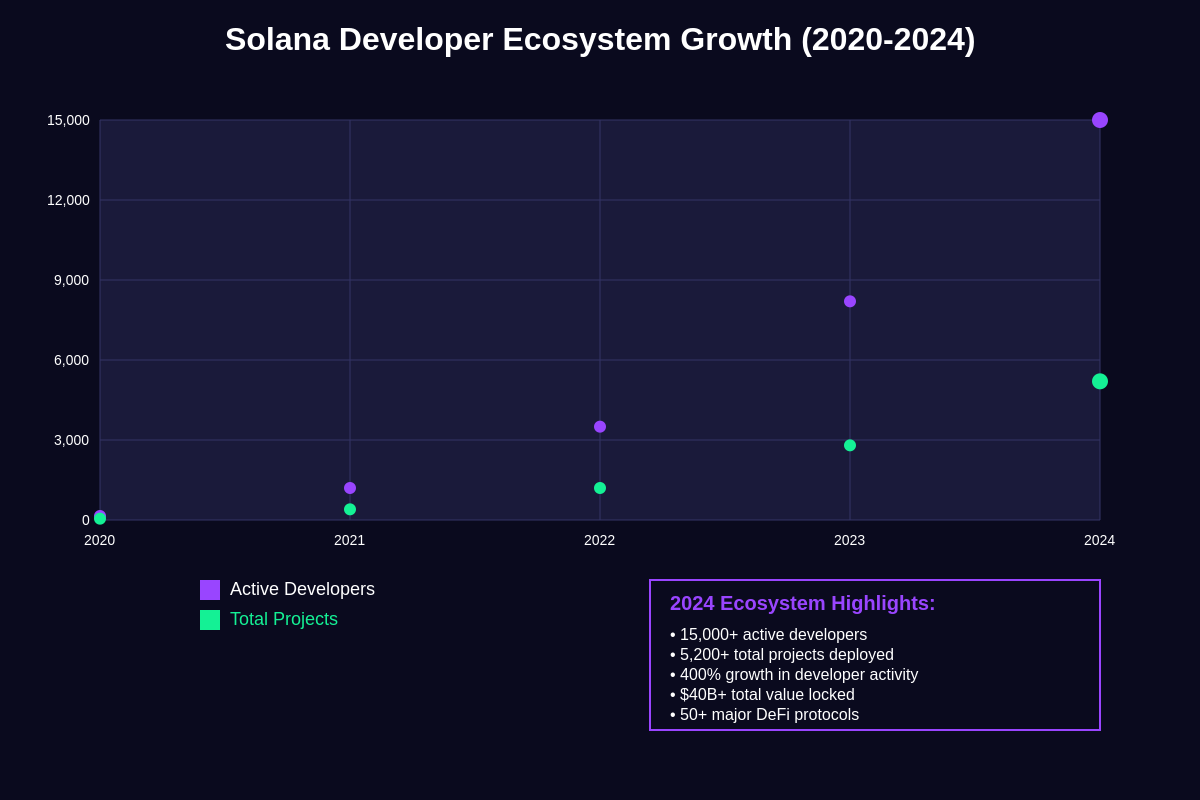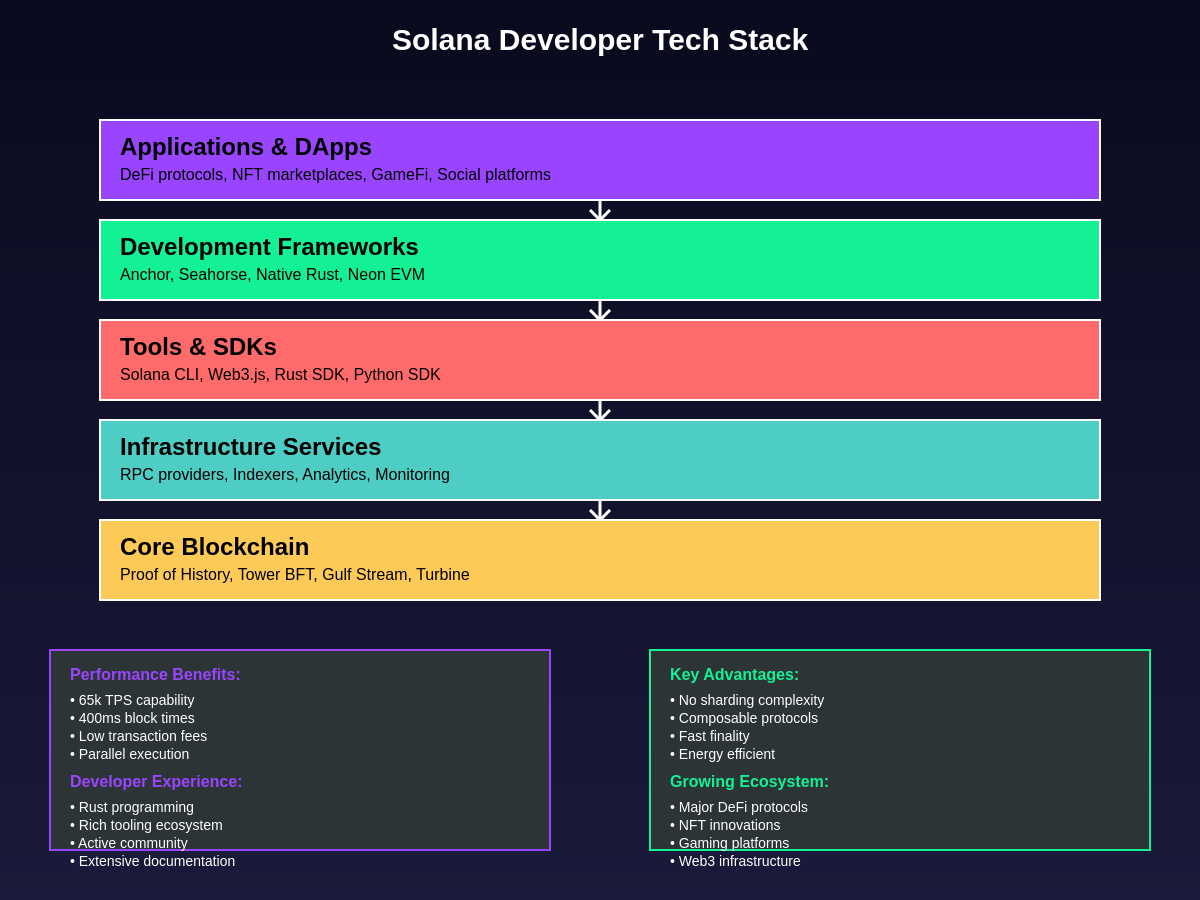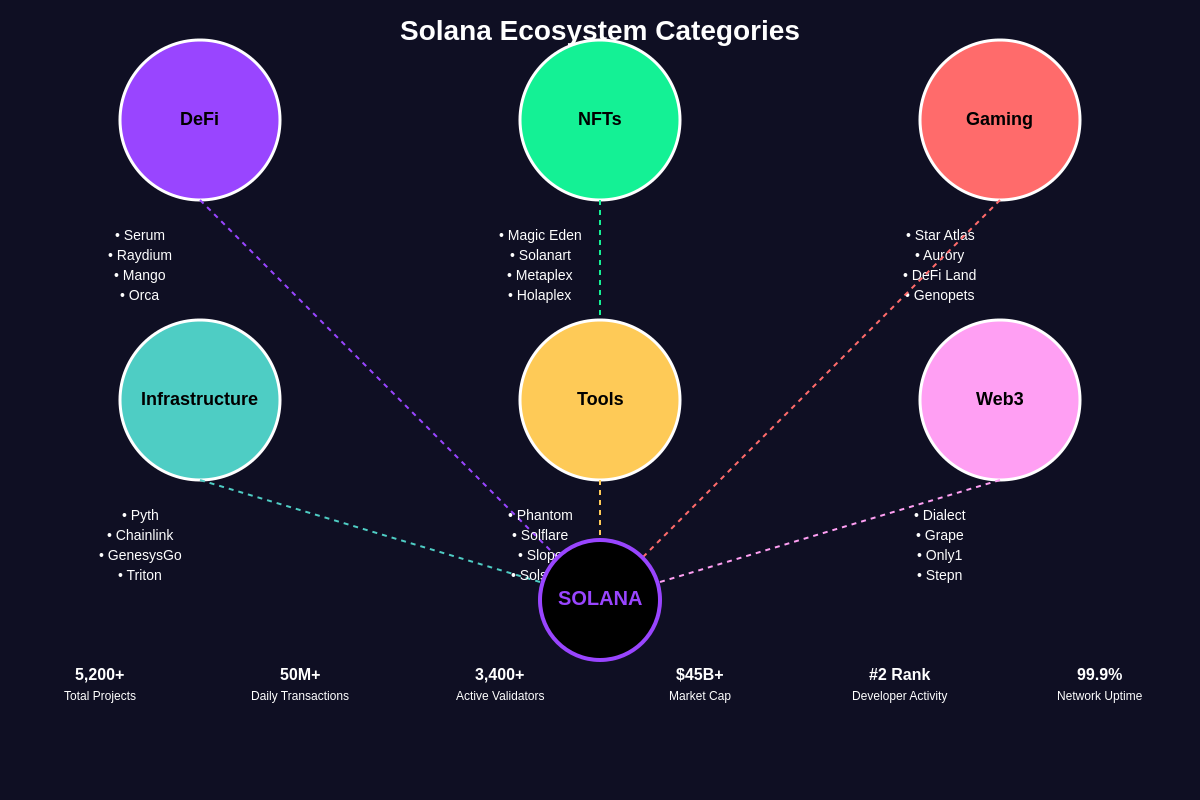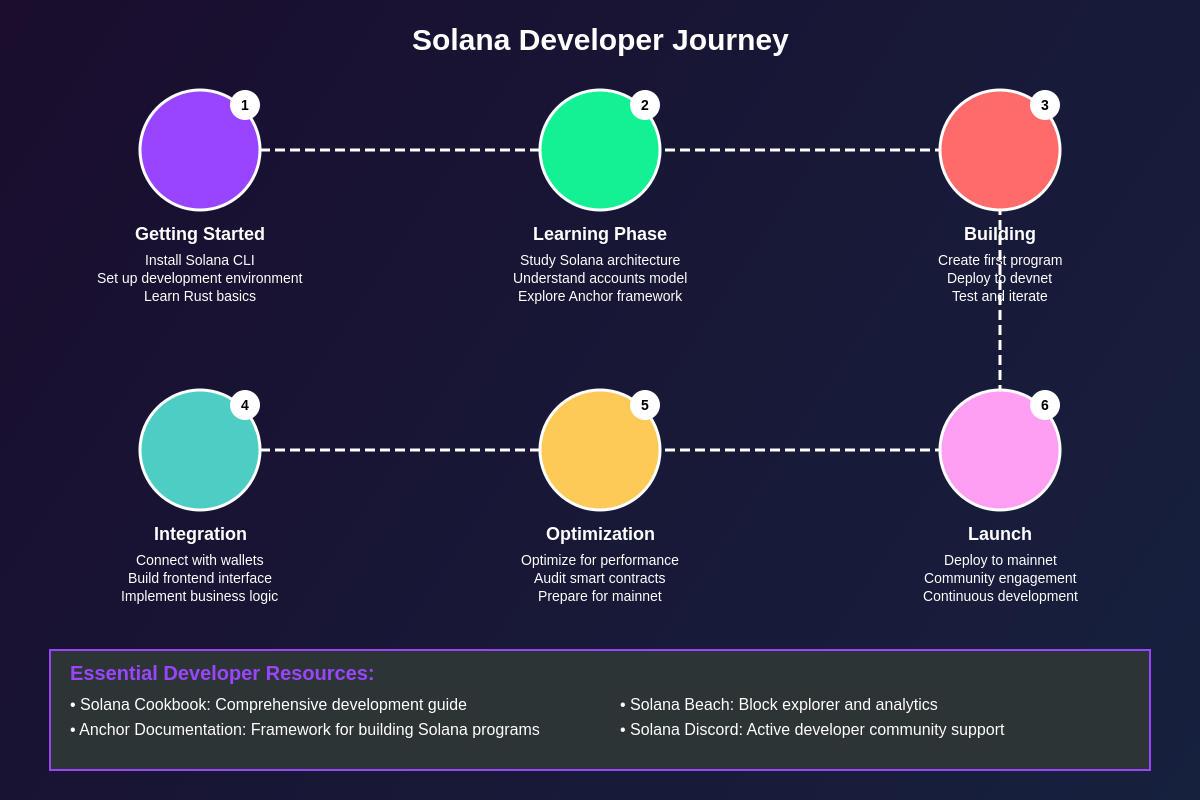The Rise of Solana as a Developer Platform
Solana has emerged as one of the most compelling blockchain platforms for developers, attracting thousands of builders who are drawn to its unique combination of high performance, low costs, and innovative architecture. Unlike traditional blockchain networks that force developers to choose between scalability and decentralization, Solana’s novel approach to consensus through Proof of History enables a development environment where applications can achieve web-scale performance without compromising on security or decentralization principles.
The explosive growth of Solana’s developer ecosystem represents a fundamental shift in how blockchain applications are conceived and built, with over 15,000 active developers currently building on the platform and more than 5,200 projects deployed across various categories including decentralized finance, non-fungible tokens, gaming, and Web3 infrastructure. This remarkable adoption rate stems from Solana’s ability to address the core pain points that have historically limited blockchain development, particularly around transaction throughput, confirmation times, and operational costs.

The technical advantages that initially attracted early adopters have evolved into a comprehensive ecosystem of tools, frameworks, and infrastructure that continues to lower the barriers to entry for new developers while providing sophisticated capabilities for experienced teams building complex applications. The result is a vibrant community of builders who have chosen Solana not just for its performance characteristics, but for the comprehensive developer experience and the growing network effects that come from being part of a rapidly expanding ecosystem.
Technical Architecture That Attracts Developers
The fundamental appeal of Solana for developers lies in its innovative technical architecture that solves the blockchain trilemma through a unique approach to consensus and validation. The Proof of History mechanism creates a verifiable passage of time between events, allowing validators to process transactions in parallel rather than sequentially, which dramatically increases throughput while maintaining the security guarantees that developers require for production applications.
Solana’s account model differs significantly from Ethereum’s contract-based approach, providing developers with more flexible and efficient ways to structure their applications. Instead of storing state within smart contracts, Solana separates code from data, allowing programs to be stateless while accounts hold the state information. This architectural decision enables more efficient resource utilization and allows developers to build applications that can scale horizontally as demand increases.
The network’s ability to process over 65,000 transactions per second with sub-second finality creates development possibilities that are simply not feasible on other blockchain platforms. Developers can build real-time applications, high-frequency trading systems, and interactive gaming experiences that would be prohibitively expensive or technically impossible on networks with lower throughput and higher latency. This performance envelope has attracted developers from traditional web2 backgrounds who were previously deterred by blockchain limitations.
The parallel processing capabilities enabled by Solana’s architecture mean that applications do not compete for limited block space in the same way they do on other networks. Developers can build complex applications without worrying about network congestion affecting their users’ experience, and the consistent low transaction fees make it economically viable to build applications with frequent user interactions that would be cost-prohibitive on other platforms.
Development Framework and Tooling Excellence
The Solana development ecosystem has matured rapidly, with a comprehensive suite of tools and frameworks that rival traditional web development environments in terms of sophistication and ease of use. The Anchor framework has emerged as the de facto standard for Solana development, providing developers with a high-level interface that abstracts away much of the complexity associated with low-level blockchain programming while maintaining the performance and security characteristics that make Solana attractive.
Anchor’s approach to smart contract development feels familiar to developers coming from traditional web frameworks, with features like automatic serialization, client generation, and testing frameworks that significantly reduce the learning curve for developers new to blockchain development. The framework’s TypeScript integration allows frontend developers to work with type-safe interfaces when interacting with on-chain programs, creating a seamless development experience that spans from smart contract development to user interface implementation.
The Solana CLI provides developers with powerful command-line tools for program deployment, account management, and network interaction that integrate seamlessly with existing development workflows. The tooling supports multiple programming languages through various SDKs, with the primary development language being Rust, which appeals to developers seeking performance and memory safety, along with JavaScript, Python, and other language bindings that make the platform accessible to developers with diverse backgrounds.
The development environment includes sophisticated debugging and testing tools that allow developers to thoroughly validate their applications before deployment. Local test validators enable rapid iteration during development, while devnet and testnet environments provide production-like conditions for comprehensive testing. The tooling ecosystem includes block explorers, analytics platforms, and monitoring services that give developers deep visibility into their applications’ on-chain behavior and performance characteristics.

Performance and Cost Advantages
The economic model of developing on Solana presents compelling advantages that have attracted developers who were previously priced out of blockchain development or forced to make compromises in their application design due to cost constraints. Transaction fees on Solana typically cost fractions of a cent, making it economically viable to build applications with frequent user interactions, micro-transactions, or complex multi-step workflows that would be prohibitively expensive on other networks.
The predictable fee structure allows developers to build sustainable business models around their applications without worrying about variable network costs affecting their unit economics. Unlike networks where transaction fees can spike during periods of high demand, Solana’s architecture maintains consistent low fees even as network usage increases, providing developers with the cost predictability they need for long-term planning and user experience design.
The high throughput capabilities of Solana enable developers to build applications that can serve millions of users without degrading performance or experiencing the scalability bottlenecks that plague other blockchain platforms. This scalability advantage is particularly important for developers building consumer-facing applications where user experience expectations are high and any friction or delays can significantly impact adoption and retention.
The fast finality times, typically 400 milliseconds for confirmation, enable developers to build responsive applications that feel more like traditional web applications rather than the slow, cumbersome experiences often associated with blockchain interactions. This responsiveness is crucial for applications like decentralized exchanges, gaming platforms, and social media applications where real-time interaction is essential for user engagement.
Rich Ecosystem and Network Effects
The rapid growth of Solana’s ecosystem has created powerful network effects that make the platform increasingly attractive to new developers. The presence of major DeFi protocols, established NFT marketplaces, and innovative gaming platforms provides new developers with existing infrastructure and user bases that they can build upon, rather than starting from scratch in an empty ecosystem.
The interconnected nature of Solana applications, enabled by the platform’s composability features, allows developers to integrate with existing protocols and services to create more sophisticated applications with less development effort. This composability advantage means that each new application adds value not just for its direct users, but for the entire ecosystem by providing new building blocks that other developers can incorporate into their projects.
The active developer community surrounding Solana provides extensive support for newcomers through documentation, tutorials, community forums, and direct mentorship programs. The Solana Foundation’s developer relations efforts have created comprehensive educational resources and funding programs that help developers overcome initial barriers and accelerate their development timelines.
The presence of established projects has also attracted significant venture capital and investor interest in the Solana ecosystem, making it easier for developers to secure funding for their projects. The combination of technical advantages, growing user bases, and available capital creates a virtuous cycle that continues to attract new developers and projects to the platform.

Programming Language and Framework Adoption
Solana’s choice of Rust as its primary programming language has proven to be a significant draw for developers who value performance, memory safety, and modern language features. Rust’s growing popularity in the broader software development community means that there is an increasing pool of developers who are already familiar with the language and can transition to blockchain development without learning entirely new programming paradigms.
The language’s emphasis on safety and performance aligns well with the requirements of blockchain development, where bugs can have significant financial consequences and performance optimization is crucial for user experience. Rust’s ownership model and compile-time guarantees help developers avoid common programming errors that could lead to security vulnerabilities or inefficient resource usage.
The Anchor framework’s integration with Rust provides developers with powerful abstractions that make blockchain-specific concepts more accessible while maintaining the performance and safety characteristics of the underlying language. The framework’s macro system allows developers to write concise code that expands into efficient on-chain programs, reducing development time while maintaining code quality.
For developers who prefer other programming languages, Solana’s ecosystem includes SDKs and tools for JavaScript, Python, Go, and other popular languages, ensuring that the platform is accessible to developers regardless of their language preferences. The multi-language support has been crucial for attracting developers from different backgrounds and enabling teams to leverage their existing expertise while building on Solana.
Infrastructure and Developer Services
The mature infrastructure ecosystem surrounding Solana provides developers with enterprise-grade services that handle the operational complexity of running blockchain applications at scale. RPC providers like QuickNode, Alchemy, and GenesysGo offer reliable, high-performance access to the Solana network with features like load balancing, caching, and analytics that are essential for production applications.
Indexing services and data providers have emerged to help developers efficiently query blockchain data and build responsive user interfaces. These services abstract away the complexity of parsing raw blockchain data and provide developers with APIs and webhooks that make it easy to build applications that respond to on-chain events in real-time.
The monitoring and analytics infrastructure available for Solana applications rivals what is available for traditional web applications, with services providing detailed insights into application performance, user behavior, and on-chain metrics. This visibility is crucial for developers who need to optimize their applications and understand how users are interacting with their services.
Developer-focused infrastructure services have also emerged to handle common requirements like wallet integration, transaction management, and user onboarding. These services allow development teams to focus on their core application logic rather than rebuilding common blockchain interaction patterns, significantly reducing development time and complexity.
Major Projects and Success Stories
The Solana ecosystem includes numerous high-profile projects that demonstrate the platform’s capabilities and serve as proof points for developers considering the platform. Serum’s decentralized exchange showed early on that Solana could handle the throughput and latency requirements of professional trading applications, while maintaining the decentralization principles that are core to DeFi.
The success of NFT marketplaces like Magic Eden and the innovative NFT projects built on Solana have demonstrated the platform’s ability to handle the high-volume, consumer-facing applications that require both performance and low costs. The gaming sector has seen particular innovation on Solana, with projects like Star Atlas and Aurory showing how the platform’s performance characteristics enable new types of blockchain gaming experiences.
Recent innovations in the DeFi space have leveraged Solana’s unique capabilities to create new financial primitives that would not be possible on other platforms. Projects like Mango Markets have built sophisticated trading platforms with features like perpetual swaps and cross-margining that rely on Solana’s high throughput and low latency.
The success of these flagship projects has created a demonstration effect that continues to attract new developers and projects to the ecosystem. Each successful application serves as both a proof of concept for what is possible on Solana and as infrastructure that future projects can build upon.
Community and Educational Resources
The Solana developer community has grown into one of the most active and supportive communities in the blockchain space, with extensive resources available for developers at all skill levels. The Solana Foundation has invested heavily in educational content, including the Solana Cookbook, comprehensive documentation, and hands-on tutorials that guide developers through the process of building their first applications.
Community-driven initiatives like hackathons, developer workshops, and mentorship programs provide opportunities for new developers to learn from experienced builders and get feedback on their projects. These events have been instrumental in onboarding new developers and fostering innovation within the ecosystem.
The active Discord community provides real-time support for developers working through technical challenges, with core contributors and experienced community members regularly providing assistance and guidance. This level of community support significantly reduces the friction associated with learning blockchain development and helps developers overcome obstacles that might otherwise prevent them from completing their projects.
Educational partnerships with universities and coding bootcamps have created structured pathways for developers to learn Solana development, ensuring a steady pipeline of new talent entering the ecosystem. These educational initiatives are crucial for the long-term growth of the developer ecosystem and help maintain the high quality of projects being built on the platform.

Financial Incentives and Funding Opportunities
The Solana ecosystem offers numerous funding opportunities for developers, ranging from grants for open-source infrastructure projects to venture capital investment for commercial applications. The Solana Foundation’s grant program has funded hundreds of projects that contribute to the ecosystem’s growth and provide valuable infrastructure for other developers to build upon.
The hackathon circuit surrounding Solana events provides developers with opportunities to prototype ideas, receive feedback from industry experts, and potentially secure funding or acceleration opportunities. These events have been responsible for launching many successful projects and serve as important networking opportunities for developers looking to connect with potential co-founders, investors, and users.
The presence of dedicated Solana-focused venture capital funds and the interest of general crypto funds in Solana projects means that developers have access to capital at various stages of their project development. This funding availability reduces the financial barriers to full-time development and allows teams to focus on building rather than fundraising.
Token launch platforms and DeFi protocols built on Solana provide developers with mechanisms to raise capital directly from their communities and users. These decentralized funding mechanisms complement traditional venture capital and provide developers with additional options for financing their projects while building engaged user communities.
Future Prospects and Continued Innovation
The trajectory of Solana’s developer ecosystem points toward continued growth and innovation as the platform matures and addresses remaining challenges. Ongoing technical improvements to the network, including enhancements to stability and developer tooling, continue to improve the development experience and attract new builders to the platform.
The expansion of Solana’s ecosystem into new verticals like supply chain management, identity verification, and enterprise applications represents significant opportunities for developers with domain expertise in these areas. The platform’s technical characteristics make it well-suited for applications that require high throughput and low latency across various industries beyond traditional DeFi and NFT use cases.
The development of layer-2 solutions and scaling technologies built on top of Solana promises to further expand the platform’s capabilities and enable new types of applications. These developments will provide developers with even more tools and options for building scalable applications while maintaining the performance advantages that make Solana attractive.
The growing integration between Solana and traditional web2 services through APIs and middleware solutions is creating new opportunities for developers to build hybrid applications that bridge the gap between blockchain and traditional internet services. This integration potential represents a significant growth area for developers who can navigate both blockchain and traditional web development.
Challenges and Considerations for Developers
While Solana offers numerous advantages for developers, there are also challenges and considerations that potential builders should understand before committing to the platform. The network has experienced stability issues during periods of high demand, which have affected application availability and user experience. While improvements continue to be made, developers need to consider these reliability factors when designing mission-critical applications.
The learning curve associated with Solana development, particularly around the account model and Rust programming, can be steep for developers coming from other blockchain platforms or traditional web development backgrounds. However, the investment in learning these concepts pays dividends in terms of the performance and capabilities that become available once developers become proficient with the platform.
The rapidly evolving nature of the Solana ecosystem means that best practices and tooling continue to change, requiring developers to stay current with new developments and potentially refactor applications as the platform evolves. This pace of change can be challenging but also provides opportunities for developers who stay at the forefront of ecosystem developments.
Competition for user attention and market share within the Solana ecosystem is intensifying as more projects launch, making it important for developers to focus on unique value propositions and excellent user experiences rather than relying solely on the technical advantages of the underlying platform.
The concentration of development activity and user adoption within certain categories like DeFi and NFTs means that developers building in less established verticals may face additional challenges in terms of user acquisition and ecosystem integration. However, this also represents opportunities for developers who can successfully establish new categories or use cases on the platform.
Despite these challenges, the combination of technical capabilities, growing ecosystem, active community, and available funding makes Solana an attractive platform for developers who are building the next generation of blockchain applications. The platform’s continued evolution and the dedication of its developer community suggest that many of the current challenges will be addressed over time, while the fundamental advantages that attract developers will continue to strengthen.
Disclaimer: This article is for informational purposes only and does not constitute financial advice. Cryptocurrency investments carry significant risks, and past performance does not guarantee future results. Always conduct your own research and consult with qualified financial advisors before making investment decisions. The views expressed are those of the author and do not necessarily reflect the opinions of any organization or entity.